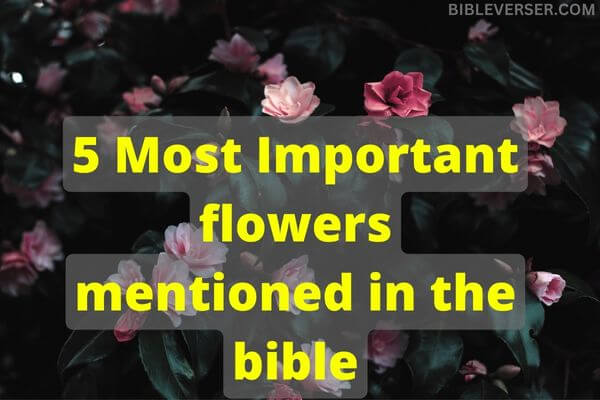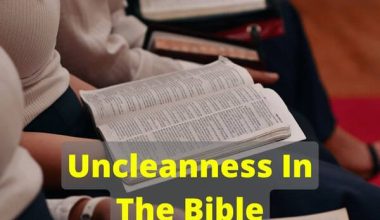Embark on a fragrant journey through the pages of the Bible, where blooms and blossoms dance in the verses, telling tales of beauty, symbolism, and divine connection.
As we stroll through the biblical garden, we will unravel the stories behind these blooms – each petal a stroke in the masterpiece of a narrative that goes beyond the visible, inviting you to discover the spiritual and cultural treasures hidden within.
5 Most Important Flowers Mentioned In the Bible
Flowers in the Bible aren’t just pretty things; they’re like colorful whispers carrying special messages. They show up in stories and teachings, adding a touch of beauty and meaning. Think of them as nature’s storytellers, sharing messages of love, purity, and divine care.
So, as you read about these blooms in the Bible, remember they’re more than petals – they’re messengers, telling us about God’s love and the beauty woven into our stories.
Rose

The rose, though not as explicitly detailed in the Bible as in later literature, is symbolically associated with beauty and fragrance.
In the Song of Solomon, an allegorical book often interpreted as a representation of God’s love for His people, the lover is likened to a lily among thorns and a rose among the wildflowers, emphasizing the unparalleled beauty and uniqueness of the beloved (Song of Solomon 2:1-2).
Symbol of Beauty and Love
In the Song of Solomon, the beloved is often compared to a lily or a rose, symbolizing beauty and love. For example, in Song of Solomon 2:1, it says, “I am a rose of Sharon, a lily of the valleys.” This is a way of expressing the beauty and uniqueness of the speaker.
Metaphorical Language
The use of “rose” in the Song of Solomon is metaphorical. It’s not referring to the modern garden rose but using the term poetically to convey a sense of beauty and admiration.
Lily
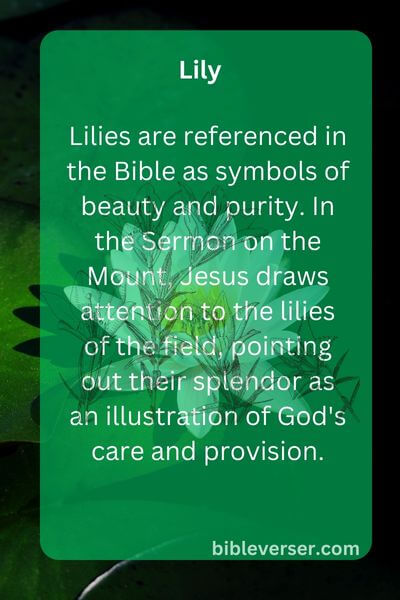
Lilies are referenced in the Bible as symbols of beauty and purity. In the Sermon on the Mount, Jesus draws attention to the lilies of the field, pointing out their splendor as an illustration of God’s care and provision.
The lily’s natural elegance becomes a metaphor for the divine attention to even the most delicate details of creation (Matthew 6:28-29).
Symbol of Beauty and Purity
The lily is a flower mentioned in various parts of the Bible, especially in poetic books like the Song of Solomon. It’s used as a symbol of beauty and purity.
For instance, in Song of Solomon 2:1, the speaker describes themselves as “a lily among thorns.”
A metaphor for God’s Care
In the teachings of Jesus in the New Testament, lilies are used as a metaphor to illustrate God’s care. In Matthew 6:28-29, Jesus says, “Consider how the lilies of the field grow.
They do not labor or spin. Yet I tell you that not even Solomon in all his splendor was dressed like one of these.” This emphasizes God’s provision and care for His creation.
Crocus (Rose of Sharon)
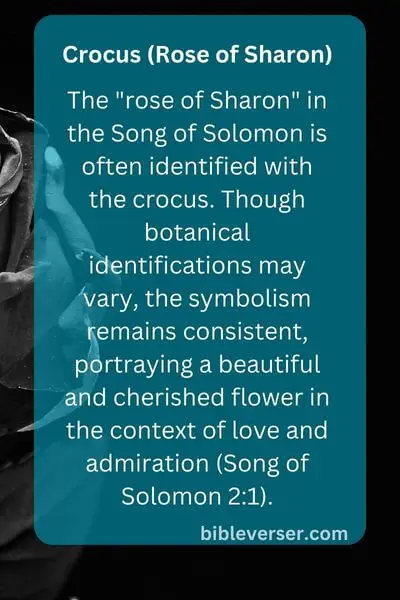
The “rose of Sharon” in the Song of Solomon is often identified with the crocus. Though botanical identifications may vary, the symbolism remains consistent, portraying a beautiful and cherished flower in the context of love and admiration (Song of Solomon 2:1).
Symbol of Beauty and Joy
The Crocus, or Rose of Sharon, is a flower mentioned in the Song of Solomon, a poetic book in the Bible. It’s used to symbolize beauty and joy. In Song of Solomon 2:1, the beloved is compared to a lily among thorns and a Rose of Sharon among the wildflowers.
A metaphor for Jesus
Some interpretations see the “Rose of Sharon” as a metaphor for Jesus Christ. It emphasizes His beauty, uniqueness, and the joy He brings. This symbolism reflects the deep love and admiration expressed in the poetic language of the Song of Solomon.
Almond Blossom
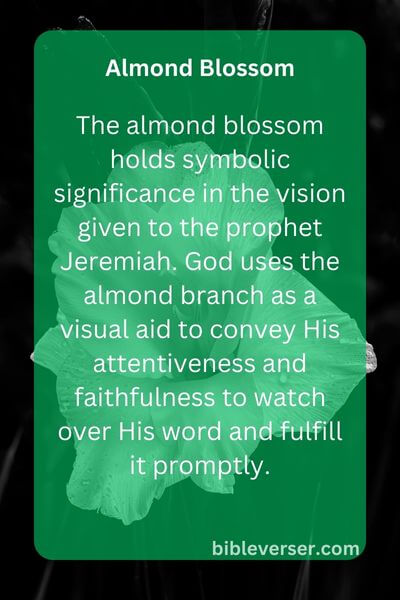
The almond blossom holds symbolic significance in the vision given to the prophet Jeremiah. God uses the almond branch as a visual aid to convey His attentiveness and faithfulness to watch over His word and fulfill it promptly.
The almond blossom, being one of the first to bloom, also signifies diligence and God’s unwavering commitment to His promises (Jeremiah 1:11-12).
Symbol of God’s Watching
The almond blossom is associated with Aaron’s staff in the Old Testament. In Numbers 17:8, God tells Moses to place the staff representing the tribe of Levi, including Aaron, in the Tabernacle.
The next day, Aaron’s staff had not only budded but also produced almond blossoms, showing that God chose the tribe of Levi for a special role.
Quick and Early Bloomer
The almond tree is one of the first trees to blossom in the spring, often even before it grows leaves. This early flowering is seen as a symbol of alertness and quick action.
In Jeremiah 1:11-12, God shows the prophet Jeremiah a vision of an almond branch to convey that He is watching over His word to perform it.
Hyssop

While technically a shrub, hyssop is mentioned in various biblical contexts. In the Old Testament, it is associated with ceremonial purification.
For instance, during the Passover, the Israelites were instructed to use a branch of hyssop to apply the blood of the sacrificial lamb to their doorposts, signifying redemption and protection (Exodus 12:22).
Purification
In the Bible, hyssop was used for rituals of cleansing and purification. For example, in the Old Testament, it was used to sprinkle blood during the Israelites’ Passover in Egypt to protect their firstborn sons (Exodus 12:22).
Cleansing from Leprosy
Hyssop was also used in the process of cleansing people from skin diseases, like leprosy. In Leviticus 14:4-7, it describes how a priest would use hyssop, along with other elements, to purify a person healed from leprosy.
Symbol of Humility
The use of hyssop in the Bible can symbolize humility and purification. When David prayed for cleansing and forgiveness in Psalm 51:7, he said, “Cleanse me with hyssop, and I will be clean; wash me, and I will be whiter than snow.” This reflects the desire for spiritual cleansing and purity.
Names Of Flowers Mentioned In The Bible
Rose
While the term “rose” as we know it may not be explicitly mentioned in the Bible, the “rose of Sharon” in the Song of Solomon is often identified with the crocus or another local flower, symbolizing beauty (Song of Solomon 2:1).
Lily
Lilies are mentioned in various passages, symbolizing beauty and purity. Jesus refers to the lilies of the field in the context of God’s care and provision (Matthew 6:28-29).
Crocus (Rose of Sharon)
The “rose of Sharon” is believed to refer to the crocus or another local flower in the Song of Solomon, symbolizing beauty and uniqueness (Song of Solomon 2:1).
Almond Blossom
The almond tree and its blossoms are mentioned symbolically in the vision given to Jeremiah, representing God’s attentiveness and faithfulness to fulfill His word promptly (Jeremiah 1:11-12).
Hyssop
Hyssop is mentioned in various ceremonial and purification contexts, including the application of blood during the Passover (Exodus 12:22). It is more of a shrub, but its branches were used symbolically.
Which Flower Is Known As Flower Of God
The “Lily of the Valley” is often symbolically referred to as the “Flower of God” in Christian tradition. This designation is rooted in its delicate beauty and its association with purity and humility, attributes often associated with divine qualities.
In the Song of Solomon, a poetic and allegorical book in the Bible, the lover is likened to a lily of the valley: “I am a rose of Sharon, a lily of the valleys” (Song of Solomon 2:1, NIV).
This metaphorical use of the lily of the valley underscores its significance in biblical imagery, associating it with beauty and grace.
The Lily of the Valley has thus become a symbol of divine purity and the grace of God. Its fragrant blossoms, often appearing in humble settings, are seen as a reflection of the gentle and pure nature of the Divine.
This symbolism has permeated Christian hymns and traditions, where the Lily of the Valley is revered as a flower representing the beauty and grace of God.
Biblical Plants And Flowers
Rose of Sharon
The Rose of Sharon is mentioned in the Song of Solomon, and while it may refer to a specific flower, its symbolic meaning is often emphasized. It is considered a symbol of beauty and excellence, representing the beloved in the poetic language of the Song of Solomon (Song of Solomon 2:1)
Lily of the Valley
Although the term “Lily of the Valley” is not explicitly used in the Bible, the concept is present in the Song of Solomon. It symbolizes purity and humility, often associated with the beloved in the poetic expressions of love (Song of Solomon 2:1).
Lily
Lilies are mentioned in various passages, symbolizing beauty and purity. In the Sermon on the Mount, Jesus uses the lilies of the field to illustrate God’s care and provision, emphasizing their natural beauty and the Creator’s attention to detail (Matthew 6:28-29).
Almond Tree and Almond Blossom
The almond tree and its blossoms hold symbolic significance. In a vision given to Jeremiah, the almond branch is used to convey God’s attentiveness and faithfulness in watching over His word to fulfill it promptly (Jeremiah 1:11-12).
Hyssop
Hyssop is mentioned in various ceremonial and purification rituals in the Bible, including the application of blood during the Passover. It symbolizes cleansing and purification, playing a role in rituals that signify spiritual purification (Exodus 12:22).
Cedar
Cedars are frequently referenced for their majesty and strength in the Bible. The metaphorical use of cedar trees signifies God’s blessings and prosperity. In Psalm 92:12, the righteous are compared to the cedars of Lebanon, symbolizing stability and endurance.
Olive Tree and Olive Branch:
Olive trees and branches are symbols of peace and prosperity throughout the Bible. The olive branch, in particular, gained significance as a symbol of peace when a dove brought it to Noah after the flood (Genesis 8:11).
Palm Tree
Palm trees symbolize victory and righteousness. They are often associated with celebrations and are mentioned in the context of righteous individuals flourishing like palm trees (Psalm 92:12, Revelation 7:9).
Myrtle
Myrtle is mentioned in passages describing God’s promise to bring joy and celebration, replacing mourning. It is symbolic of the transformation of sorrow into joy, reflecting God’s redemptive work (Isaiah 55:13).
Fig Tree
The fig tree is referenced in various contexts, symbolizing prosperity and peace. Jesus also used the fig tree as an illustration in his teachings, emphasizing the need for spiritual fruitfulness (Matthew 21:18-22).
Short Bible Verses About Flowers
Genesis 2:9 (NIV)
“The Lord God made all kinds of trees grow out of the ground—trees that were pleasing to the eye and good for food. In the middle of the garden were the tree of life and the tree of the knowledge of good and evil.”
Psalm 23:1-2 (NIV)
“The Lord is my shepherd, I lack nothing. He makes me lie down in green pastures, he leads me beside quiet waters.”
Psalm 92:12-14 (NIV)
“The righteous will flourish like a palm tree, they will grow like a cedar of Lebanon; planted in the house of the Lord, they will flourish in the courts of our God. They will still bear fruit in old age, they will stay fresh and green.”
Ecclesiastes 3:1-2 (NIV)
“There is a time for everything, and a season for every activity under the heavens: a time to be born and a time to die, a time to plant and a time to uproot.”
Isaiah 55:10-11 (NIV)
“As the rain and the snow come down from heaven, and do not return to it without watering the earth and making it bud and flourish, so that it yields seed for the sower and bread for the eater, so is my word that goes out from my mouth: It will not return to me empty but will accomplish what I desire and achieve the purpose for which I sent it.”
Jeremiah 17:8 (NIV)
“They will be like a tree planted by the water that sends out its roots by the stream. It does not fear when heat comes; its leaves are always green. It has no worries in a year of drought and never fails to bear fruit.”
Joel 2:22 (NIV)
“Do not be afraid, you wild animals, for the pastures in the wilderness are becoming green. The trees are bearing their fruit; the fig tree and the vine yield their riches.”
Matthew 13:3-8 (NIV)
“Then he told them many things in parables, saying: ‘A farmer went out to sow his seed. As he was scattering the seed, some fell along the path, and the birds came and ate it up.'”
Mark 4:26-29 (NIV)
“He also said, ‘This is what the kingdom of God is like. A man scatters seed on the ground. Night and day, whether he sleeps or gets up, the seed sprouts and grows, though he does not know how.'”
Luke 8:15 (NIV)
“But the seed on good soil stands for those with a noble and good heart, who hear the word, retain it, and by persevering produce a crop.”
John 12:24 (NIV)
“Very truly I tell you, unless a kernel of wheat falls to the ground and dies, it remains only a single seed. But if it dies, it produces many seeds.”
1 Corinthians 3:6-7 (NIV)
“I planted the seed, Apollos watered it, but God has been making it grow. So neither the one who plants nor the one who waters is anything, but only God, who makes things grow.”
Galatians 6:7-8 (NIV)
“Do not be deceived: God cannot be mocked. A man reaps what he sows. Whoever sows to please their flesh, from the flesh will reap destruction; whoever sows to please the Spirit, from the Spirit will reap eternal life.”
Colossians 2:6-7 (NIV)
“So then, just as you received Christ Jesus as Lord, continue to live your lives in him, rooted and built up in him, strengthened in the faith as you were taught, and overflowing with thankfulness.”
Revelation 22:2 (NIV)
“Down the middle of the great street of the city. On each side of the river stood the tree of life, bearing twelve crops of fruit, yielding its fruit every month. And the leaves of the tree are for the healing of the nations.”
Psalm 65:9-10 (NIV)
“You care for the land and water it; you enrich it abundantly. The streams of God are filled with water to provide the people with grain, for so you have ordained it. You drench its furrows and level its ridges; you soften it with showers and bless its crops.”
Proverbs 16:15 (NIV)
“When a king’s face brightens, it means life; his favor is like a rain cloud in spring.”
Isaiah 61:11 (NIV)
“For as the soil makes the sprout come up and a garden causes seeds to grow, so the Sovereign Lord will make righteousness and praise spring up before all nations.”
Ezekiel 36:30 (NIV)
“I will increase the fruit of the trees and the crops of the field, so that you will no longer suffer disgrace among the nations because of famine.”
Hosea 2:21-22 (NIV)
“In that day I will respond, declares the Lord— I will respond to the skies, and they will respond to the earth; and the earth will respond to the grain, the new wine and the olive oil, and they will respond to Jezreel.”
Matthew 13:31-32 (NIV)
“He told them another parable: ‘The kingdom of heaven is like a mustard seed, which a man took and planted in his field. Though it is the smallest of all seeds, yet when it grows, it is the largest of garden plants and becomes a tree, so that the birds come and perch in its branches.'”
Matthew 21:18-22 (NIV)
“Early in the morning, as Jesus was on his way back to the city, he was hungry. Seeing a fig tree by the road, he went up to it but found nothing on it except leaves. Then he said to it, ‘May you never bear fruit again!’ Immediately the tree withered.”
Mark 11:20-21 (NIV)
“In the morning, as they went along, they saw the fig tree withered from the roots. Peter remembered and said to Jesus, ‘Rabbi, look! The fig tree you cursed has withered!'”
Luke 13:6-9 (NIV)
“Then he told this parable: ‘A man had a fig tree growing in his vineyard, and he went to look for fruit on it but did not find any. So he said to the man who took care of the vineyard, ‘For three years now I’ve been coming to look for fruit on this fig tree and haven’t found any. Cut it down! Why should it use up the soil?'”
John 15:1-2 (NIV)
“I am the true vine, and my Father is the gardener. He cuts off every branch in me that bears no fruit, while every branch that does bear fruit he prunes so that it will be even more fruitful.”
1 Corinthians 15:36-38 (NIV)
“How foolish! What you sow does not come to life unless it dies. When you sow, you do not plant the body that will be, but just a seed, perhaps of wheat or of something else. But God gives it a body as he has determined, and to each kind of seed he gives its own body.”
2 Corinthians 9:6 (NIV)
“Remember this: Whoever sows sparingly will also reap sparingly, and whoever sows generously will also reap generously.”
Galatians 5:22-23 (NIV)
“But the fruit of the Spirit is love, joy, peace, forbearance, kindness, goodness, faithfulness, gentleness and self-control. Against such things there is no law.”
James 3:17-18 (NIV)
“But the wisdom that comes from heaven is first of all pure; then peace-loving, considerate, submissive, full of mercy and good fruit, impartial and sincere. Peacemakers who sow in peace reap a harvest of righteousness.”
Revelation 21:5 (NIV)
“He who was seated on the throne said, ‘I am making everything new!’ Then he said, ‘Write this down, for these words are trustworthy and true.'”
Matthew 6:28-29 (NIV)
“And why do you worry about clothes? See how the flowers of the field grow. They do not labor or spin. Yet I tell you that not even Solomon in all his splendor was dressed like one of these.”
Psalm 103:15-16 (NIV)
“The life of mortals is like grass, they flourish like a flower of the field; the wind blows over it and it is gone, and its place remembers it no more.”
Isaiah 40:8 (NIV)
“The grass withers and the flowers fall, but the word of our God endures forever.”
1 Peter 1:24-25 (NIV)
“For, ‘All people are like grass, and all their glory is like the flowers of the field; the grass withers and the flowers fall, but the word of the Lord endures forever.'”
Song of Solomon 2:12 (NIV)
“Flowers appear on the earth; the season of singing has come, the cooing of doves is heard in our land.”
James 1:10-11 (NIV)
“But the rich should take pride in their humiliation—since they will pass away like a wild flower. For the sun rises with scorching heat and withers the plant; its blossom falls and its beauty is destroyed. In the same way, the rich will fade away even while they go about their business.”
Isaiah 35:1-2 (NIV)
“The desert and the parched land will be glad; the wilderness will rejoice and blossom. Like the crocus, it will burst into bloom; it will rejoice greatly and shout for joy.”
Hosea 14:5-6 (NIV)
“I will be like the dew to Israel; he will blossom like a lily. Like a cedar of Lebanon he will send down his roots; his young shoots will grow. His splendor will be like an olive tree, his fragrance like a cedar of Lebanon.”
Luke 12:27-28 (NIV)
“Consider how the wild flowers grow. They do not labor or spin. Yet I tell you, not even Solomon in all his splendor was dressed like one of these. If that is how God clothes the grass of the field, which is here today, and tomorrow is thrown into the fire, how much more will he clothe you—you of little faith!”
Psalm 104:14-15 (NIV)
“He makes grass grow for the cattle, and plants for people to cultivate—bringing forth food from the earth: wine that gladdens human hearts, oil to make their faces shine, and bread that sustains their hearts.”
List Of Plants Mentioned In The Bible
Cedar
The cedar tree is renowned for its strength and durability. In biblical contexts, cedar wood was highly valued and often used in construction, including the building of Solomon’s temple. The use of cedar symbolizes endurance and the enduring nature of God’s blessings (1 Kings 5:10-12).
Coriander
Coriander is mentioned in connection with manna, the miraculous food provided to the Israelites in the wilderness. This small seed highlights the delicate and fine nature of manna, emphasizing God’s detailed provision for His people (Exodus 16:31, Numbers 11:7).
Cypress:
Described as a tree of beauty, the cypress is mentioned poetically in the context of ornamentation. The mention of cypress trees suggests an aesthetic appreciation for these trees and their use in enhancing beauty (Isaiah 44:14).
Fig Tree
The fig tree holds symbolic significance in biblical narratives, representing prosperity and peace. It is mentioned in stories such as Jesus cursing a barren fig tree, symbolizing the consequences of unfruitfulness (Matthew 21:18-22).
Flax:
Flax is mentioned in the context of spinning and making linen. This plant played a crucial role in ancient textiles, highlighting the importance of such resources in daily life and cultural practices (Proverbs 31:13).
Grapevine
Symbolizing Israel and God’s people, the grapevine holds rich metaphorical meaning. The image of a fruitful vineyard is used to convey the relationship between God and His chosen people, emphasizing the expectation of spiritual fruitfulness (Psalm 80:8, Jeremiah 2:21).
Hyssop
Hyssop is mentioned in various ceremonial and purification rituals, including the application of blood during the Passover. Its use symbolizes cleansing and purification, highlighting the importance of ritualistic practices in the biblical context (Exodus 12:22).
Lily
The lily symbolizes beauty and purity. Jesus references the lilies of the field to illustrate God’s care and provision, emphasizing the natural beauty and providence of God (Matthew 6:28-29).
Mandrake:
The mandrake is mentioned in the context of Rachel and Leah. The story illustrates the cultural beliefs surrounding mandrakes, emphasizing their perceived fertility properties in ancient times (Genesis 30:14-16).
Mustard Plant:
The mustard plant is used in a parable by Jesus to illustrate the kingdom of God. Despite its small beginnings, the mustard seed grows into a large plant, symbolizing the expansive and transformative nature of God’s kingdom (Matthew 13:31-32).
Myrtle:
Myrtle is mentioned in passages describing God’s promise to bring joy and celebration, replacing mourning. Its inclusion signifies the transformative power of God’s promises, turning sorrow into joy (Isaiah 55:13).
Olive Tree:
The olive tree symbolizes peace and prosperity throughout the Bible. Olive oil, derived from its fruit, has ceremonial and practical uses, underscoring its significance in biblical culture.
Palm Tree:
The palm tree symbolizes victory and righteousness. It is often associated with celebrations and is mentioned in the context of the righteous flourishing like palm trees (Psalm 92:12, Revelation 7:9).
Papyrus:
Papyrus is mentioned in the Bible and was used for making a paper-like material. This plant underscores the practical applications of vegetation in ancient cultures, including writing materials (Job 8:11).
Rose of Sharon:
The “Rose of Sharon” is mentioned in the Song of Solomon, symbolizing beauty. Though its exact identification is debated, the term is often associated with a beautiful and cherished flower in the poetic expressions of love (Song of Solomon 2:1).
Sycamore Fig Tree:
Mentioned in the context of Zacchaeus, the sycamore fig tree adds a specific detail to the story. It emphasizes the setting of the encounter and provides a visual element to the narrative (Luke 19:4).
Thistles and Thorns:
Thistles and thorns are symbols of difficulties and challenges. They are mentioned in the context of the consequences of sin, highlighting the struggles faced in a fallen world (Genesis 3:18).
Terebinth Tree
The terebinth tree is mentioned in various contexts, including Deborah’s Oak. These trees were often associated with significant locations and events, adding depth to the biblical narrative (Genesis 35:8).
Wheat
Wheat is a common grain used for food and offerings. It symbolizes sustenance and provision in many biblical contexts.
Willow Tree
Mentioned in the context of the Feast of Tabernacles, the willow tree is part of the symbolism associated with this festival, underscoring its cultural and religious significance (Leviticus 23:40).
Conclusion
As believers, let’s remember that these blooms aren’t just there to look pretty. They’re like nature’s symbols, telling us stories about God’s love, care, and the beauty in our lives.
Whether it’s a lily, a rose, or any bloom in the biblical garden, each one has a special meaning. So, as you see flowers around, maybe you’ll remember the stories they tell – stories of love, hope, and the colorful moments in our lives, painted by the hands of the Creator.
Frequently Asked Questions
Is the rose mentioned in the Bible?
The word “rose” does not appear in many translations of the Bible. However, the Song of Solomon (Song of Songs) often uses metaphorical language about love and beauty, and some interpretations suggest that the term “rose” may be implied symbolically.
How is the lily mentioned in the Bible?
The lily is mentioned in various verses, often symbolizing beauty and purity. In the Song of Solomon, lilies are a recurring motif representing beauty and grace. Jesus also refers to the lilies of the field in Matthew 6:28-29, highlighting God’s care for His creation.
Is the crocus mentioned in the Bible?
The crocus is not explicitly mentioned in many translations. However, Isaiah 35:1-2 uses the term “crocus” in some translations to describe the blossoming of the desert, signifying a time of renewal and joy.
What is the significance of hyssop in the Bible?
Hyssop is mentioned in the Bible in various contexts, often associated with purification. It was used in rituals for cleansing and played a role in events such as the Passover in Exodus 12:22 and the cleansing of lepers in (Leviticus 14:4-7.)
How are olive trees and olive branches mentioned in the Bible?
Olive trees and branches are frequently mentioned in the Bible, symbolizing peace, prosperity, and the anointing of the Holy Spirit. The olive branch is famously associated with the story of Noah’s Ark, where a dove brought an olive leaf, signaling the end of the flood (Genesis 8:11).

